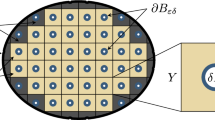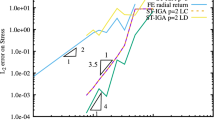Summary
A method for the formulation of elastostatical boundary value problems as integral equations is presented, the basic idea of which consists of superimposing in a suitable fashion singular solutions for the infinite medium. Since mechanical aspects play an important role in the concept of the method, all quantities in the equations can be interpreted physically. The applicability of the method is illustrated by examples of the geometrical and statical boundary value problem ofplane elastostatics for which 32 different formulations as integral equations are established.
The second aim of the paper consists of revealing an analogy between the most important notions of the singularity method, viz. between state variables and singularities. The analogy is manifested by certain symmetries of influence functions, and enables the systematical representation of the basic relations and their interpretation within a larger context.
Zusammenfassung
Es wird eine Methode zur Formulierung von Randwertproblemen der Elastostatik als Integralgleichungen beschrieben, deren Grundgedanke darin besteht, singuläre Lösungen für das unendliche Medium in geeigneter Weise zu überlagern. Da beim Aufstellen der Gleichungen mechanische Gesichtspunkte im Vordergrund stehen, lassen sich alle auftretenden mathematischen Größen physikalisch deuten. Die Anwendbarkeit der Methode wird anhand des geometrischen und des statischen Randwertproblems derebenen Elastostatik erklärt. Es ergeben sich dabei 32 verschiedene Formulierungen der Probleme als Integralgleichungen.
Weiterhin wird in dem Aufsatz eine Analogie zwischen den wichtigsten Begriffen der Singularitätenmethode, den Zustandsgrößen und den Singularitäten, aufgedeckt. Die Analogie macht sich durch gewisse Symmetrien der Einflußfunktionen bemerkbar und erlaubt es, die grundlegenden Beziehungen systematisch darzustellen und in einen größeren Zusammenhang einzuordnen.
Similar content being viewed by others
Abbreviations
- χ:
-
Airy's stress function
- u i :
-
displacement vector
- πi :
-
stress function vector
- U ij :
-
distortion tensor
- ∏ ij :
-
stress tensor
- U i :
-
distortion vector
- {ei33-3}:
-
stress vector
- N :
-
collective denotation for state variables
- v :
-
wedge dislocation
- C i :
-
edge dislocation
- R i :
-
single force
- G i :
-
Rieder's singularity
- F i :
-
Massonnet's singularity
- c i :
-
generating vector ofc ij
- r i :
-
generating vector ofr ij
- g i :
-
generating vector ofg ij
- f i :
-
generating vector off ij
- c ij :
-
dipole ofC i
- r ij :
-
dipole ofR i
- g ij :
-
dipole ofG i
- f ij :
-
dipole ofF i
- M :
-
collective denotation for singularities
- m i :
-
dipole of a singularityM
- d :
-
moment of a force dipole
- b :
-
dilation intensity of a force dipole
- (NM):
-
collective denotation for influence functions further influence functions: see Chapters 4.1, 4.2
- [NM]:
-
collective denotation for proportionality factors of non integral terms corresponding to (NM). further proportionality factors see Chapter 8
- x i,\(\bar x_i\) :
-
radius vector of the field and source point respectively
- \(\bar x_i\),q i :
-
vector and unit vector respectively in the direction of the connecting line between the field and the source point
- ϱ:
-
distance between the field and the source point
- S :
-
curve on the infinite plane congruent to the boundary of the elastic body
- S 1,S 2 :
-
sections ofS
- Ŝ :
-
curve equidistant fromS
- s,\(\bar s\) :
-
arc length of a field and a source point respectively onS
- ŝ :
-
arc length of a field point onŠ
- ni,\(\bar n_i\) :
-
normal vector ofS at the field and the source point respectively
- κ:
-
curvature ofS
- ∂i,\(\bar \partial _i\) :
-
vector of differentiation with respect to field and source point co-ordinates respectively
- δij :
-
identity tensor
- e ij :
-
permutation tensore 11=e 22=0e 12=−e 21=1
- m :
-
Poisson's ratio
- G :
-
shear modulus
- \(\left| {\oint {} } \right|\left| {\int {} } \right|\) :
-
Cauchy principal value
- b i :
-
arbitrary constant vector
References
Kupradze, V. D.: Potential methods in the theory of elasticity. London: Oldbourne Press. 1965.
Kupradze, V. D., Gegelia, T. G., Baschelejschwili, M. O., Burtschuladze, T. V.: Three-Dimensional Problems of the Mathematical Theory of Elasticity and Thermoelasticity (in Russian). Moskau: Nauka. 1976.
Rizzo, F. J.: An integral equation approach to boundary value problems of classical elastostatics. Quarterly Appl. Math.25, 83–95 (1967).
Rizzo, F. J., Shippy, D. J.: A Method for Stress Determination in Plane Anisotropic Elastic Bodies. J. Composite Materials4, 36–61 (1970).
Cruse, T. A., Rizzo, F. J. (eds.): Boundary-Integral Equation Method: Computational Applications in Applied Mechanics. The American Society of Mechanical Engineers ASME, Applied Mechanics Division AMD11 (1975).
Cruse, T. A.: Numerical solutions in three dimensional elastostatics. Int. J. Solids Structures5, 1259–1274 (1969).
Cruse, T. A.: An Improved Boundary-Integral Equation Method for Three Dimensional Elastic Stress Analysis. Computers and Structures4, 741–754 (1974).
Mayr, M.: Ein Integralgleichungsverfahren zur Lösung rotationssymmetrischer Elastizitätsprobleme. Thesis, München, 1975.
Bart, J.: Kombination eines Integralgleichungsverfahrens mit der Methode der Finiten Elemente zur Berechnung ebener Spannungskonzentrationsprobleme. Thesis, München, 1974.
Muskhelishvili, N. I.: Some Basic Problems of the Mathematical Theory of Elasticity. Leyden: Noordhoff International Publishing. 1975.
Miche, R.: Le calcul pratique de problèmes élastiques à deux dimensions par la méthode des équations intégrales. Proc. 2nd Int. Congr. Techn. Mechanics, Zürich, 126–130 (1926).
Weinel, E.: Die Integralgleichung des ebenen Spannungszustandes und der Plattentheorie. ZAMM11, 349–360 (1931).
Massonnet, Ch.: Resolution graphomécanique des problèmes généraux de l'élasticité plane. Bull. CERES Liège4, 3–183 (1949).
Massonnet, Ch.: Solution générale du problème aux tensions de l'élasticité tridimensionnelle. Proc. 9th Congr. Appl. Mech., Bruxelles, 168–180 (1956).
Massonnet, Ch.: Numerical use of integral procedures, in: Stress Analysis (Zienkiewicz, O. C., Holister, G. S., eds.). London-New York-Sidney: John Wiley and Sons. 1965.
Rieder, G.: Iterationsverfahren und Operatorgleichungen in der Elastizitätstheorie. Abh. Braunschweig. Wiss. Ges.14, 109–343 (1962).
Rieder, G.: Mechanische Deutung und Klassifizierung einiger Integralverfahren der ebenen Elastizitätstheorie I, II. Bull. Acad. Pol. Sci., Sér. Sci. Techn.16, 101–114 (1968).
Rieder, G.: Über Eingrenzungsverfahren und Integralgleichungsmethoden für elastische Scheiben, Platten und verwandte Probleme. Wiss. Z. der Hochschule für Architektur und Bauwesen Weimar19/2, 217–222 (1972).
Rieder, G.: Eine Variante zur Integralgleichung von Windisch für das Torsionsproblem. ZAMM49, 351–358 (1969).
Rieder, G.: On Kupradze's generalized Stress, its Physical Meaning and its Application to certain Integral Operators of Plane Elasticity. Anniversary H. Parkus, Wien 1974.
Rieder, G.: Adjoint Integral Equations in Elasticity. In: Schiffstechnisches Symposium, Experimentelle und mathematische Methoden der Grundlagenforschung in der Schiffstechnik, Rostock, 141–151 (1975).
Rieder, G., Heise, U., Pahnke, U., Antes, H., Glahn, H., Kompis, V.: Berechnung von elastischen Spannungen in beliebig krummlinig berandeten Scheiben und Platten. (Forschungsberichte des Landes Nordrhein-Westfalen 2552.) Opladen: Westdeutscher Verlag. 1976.
Heise, U.: Formulierung und Ordnung einiger Integralverfahren für Probleme der ebenen und räumlichen Elastostatik unter besonderer Berücksichtigung mechanischer Gesichtspunkte. Habilitationthesis, Aachen, 1975.
Heise, U.: Eine Integralgleichungsmethode zur Lösung des Scheibenproblems mit gemischten Randbedingungen. Thesis, Aachen, 1969.
Heise, U.: Lösung des gemischten Randwertproblems der ebenen Elastizitätstheorie mit Hilfe singulärer Integralgleichungen. ZAMM53, 361–366 (1973).
Chicurel, R., Suppiger, E. W.: The Reflection Method in Elasticity and Bending of Plates. ZAMP15, 629–638 (1964).
Friemann, H.: Anwendung eines Integralverfahrens auf die Berechnung elastischer Scheiben mit statischen oder geometrischen Randbedingungen unter der Einwirkung beliebiger Rand- oder Innenlasten. Veröffentlichungen des Instituts für Statik und Stahlbau der Technischen Hochschule Darmstadt23 (1973).
Oliveira, E. R.: Plane Stress Analysis by a General Integral Method. Journal of the Engineering Mechanics Division ASCE 94 EM 1, 79–101 (1968).
Borgwardt, F.: Berechnung von krummlinig berandeten Scheiben mit Hilfe eines Integralgleichungsverfahrens. Thesis, Braunschweig, 1965.
Benjumea, R., Sikarskie, D. L.: On the Solution of Plane Orthotropic Elasticity Problems by an Integral Method. J. Appl. Mech.39, 801–808 (1972).
Heise, U.: Lösung des geometrischen Randwertproblems für Scheiben mit Hilfe von Stufenversetzungen. ZAMM51, T112-T114 (1971).
Heise, U.: Integralgleichungen auf unterschiedlichen Integrationsstufen für Randwertprobleme der ebenen Elastostatik. ZAMM55, T90-T91 (1975).
Heise, U.: Konstruktion der Kerne von Integralgleichungen für Randwertprobleme der ebenen Elastizitätstheorie. Proc. of the XI. Yugoslav Congress of Mech., 133–141 (1972).
Heise, U.: Die Erzeugung von Singularitäten für Integralverfahren der Elastostatik. ZAMM54, T82-T84 (1974).
Heise, U.: The Calculation of Cauchy Principal Values in Integral Equations for Boundary Value Problems of the Plane and Three-Dimensional Theory of Elasticity. J. of Elasticity5, 99–110 (1975).
Heise, U.: Non-Integral Terms in Integral Equations in the Plane and Three-Dimensional Theory of Elasticity. Mech. Res. Comm.3, 119–124 (1976).
Kompis, V.: Integralgleichungsverfahren zur Lösung der ersten Randwertaufgabe der ebenen Elastizitätstheorie. Thesis, Aachen, 1970.
Grüters, H.: Berechnung des Spannungszustandes in homogenen anisotropen Scheiben mit Hilfe einer Integralgleichungsmethode. Thesis, Aachen, 1971.
Glahn, H.: Eine Integralgleichung zur Berechnung gelenkig gelagerter Platten mit krummem Rand. Ingenieur-Archiv44, 189–198 (1975).
Zech, M.: Die Anwendung des Singularitätenverfahrens bei der Lösung ebener und räumlicher Elastizitätsprobleme. Thesis, Schwerin, 1973.
Dirlewanger, H.: Beiträge zur Spannungsermittlung mit Singularitätenverfahren. Thesis, Clausthal, 1972.
Banerjee, P. K.: Integral equation methods for analysis of piece-wise non-homogeneous three-dimensional elastic solids of arbitrary shape. Int. J. Mechanical Sciences18, 293–303 (1976).
Pahnke, U.: Berechnung von beliebig geformten Scheiben und Platten mit ausspringenden Ecken und geschlitzten Scheiben mit Hilfe eines Integralgleichungsverfahrens. Thesis, Aachen, 1970.
Heise, U.: The spectra of some integral operators for plane elastostatical boundary value problems. J. of Elasticity8, 47–49 (1978).
Lott, H., Rieder, G.: Über das Spektrum singulärer Integraloperatoren in der Elastizitätstheorie. Wiss. Z. d. TH Karl-Marx-Stadt11, 329–333 (1969).
Heise, U.: Über die Spektren einiger Integraloperatoren für die isotrope elastische Kreisscheibe. ZAMM50, T122-T124 (1970).
Heise, U.: Nachweis der Eigenwerte 0 und -1 in den Spektren von Integraloperatoren der ebenen Elastizitätstheorie. Acta Mechanica15, 177–190 (1972).
Heise, U.: Eigenwerte und Eigenfunktionen eines Integraloperators der Elastizitätstheorie für den Halbraum. ZAMM52, T128-T130 (1972).
Heise, U.: Numerical properties of integral equations in which the given boundary values and the sought solutions are defined on different curves. Computers and Structures.8, 199–205 (1978).
Kröner, E.: Kontinuumstheorie der Versetzungen und Eigenspannungen. Berlin-Göttingen-Heidelberg: Springer. 1958.
Author information
Authors and Affiliations
Additional information
With 10 Figures
Rights and permissions
About this article
Cite this article
Heise, U. Application of the singularity method for the formulation of plane elastostatical boundary value problems as integral equations. Acta Mechanica 31, 33–69 (1978). https://doi.org/10.1007/BF01261186
Received:
Revised:
Published:
Issue Date:
DOI: https://doi.org/10.1007/BF01261186




